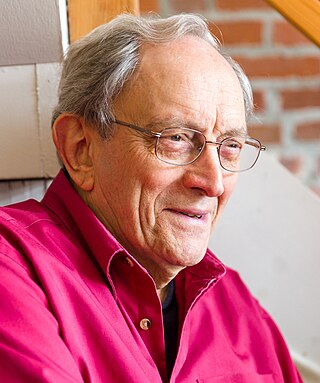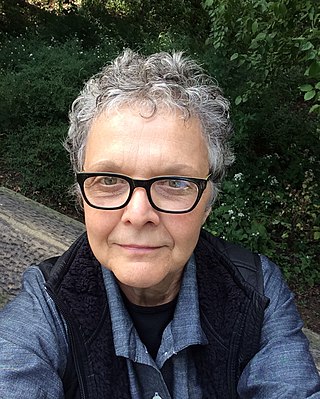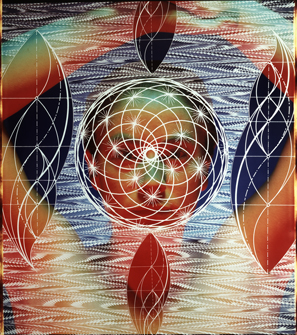
Linda Lindroth (born 1946) is an American artist, photographer, writer, curator and educator. [1]

Linda Lindroth (born 1946) is an American artist, photographer, writer, curator and educator. [1]
Lindroth was born Linda Lee Hammer in Miami, Florida, in 1946. Her father Mark (Morris) Roger Hammer [2] [3] was a manager of a series of hotels in Miami Beach after serving in the United States Army Air Force during World War II. Her mother, Mae (Maisie) Lang Hammer, was a homemaker. When Lindroth was seven years old her father moved the family to Coral Gables, Florida, where she became an avid photographer of tourist sights like the Coral Castle, the Serpentarium and the Parrot Jungle with her Brownie camera. When she was ten her father, then a traveling salesman for White Laboratories, a pharmaceutical company, took her with him on a business trip to New Orleans, where she photographed the St. Louis Cathedral. When she was 13, her father moved the family to Springfield, New Jersey. [4]
Maisie Hammer was diagnosed with bipolar disorder and was hospitalized frequently for depression. In manic episodes she would shred family photographs, including her daughter's photographs and early journals. [5]
Lindroth attended Douglass College/Rutgers University from 1964 to 1968 where she was photography editor of the yearbook, wrote a column for the school newspaper and worked part-time at the Rutgers Division of Instructional Television. She convinced a graduate student to teach her how to process, film and made her own prints in the school darkroom, though there were no formal photography courses. She focused instead on traditional printmaking with [6] Geoffrey Hendricks, who introduced her to the Happening scene in New York City.[ clarification needed ] Lindroth graduated with a B.A. in Studio Art in 1968. She continued to take courses throughout the 1970s. [7]
She studied photographic printmaking with George A. Tice at The New School in 1974. [8]
In 1975 Lindroth heard that architect turned sculptor Gordon Matta-Clark was to teach a course at the School of Visual Arts. She enrolled in the course and studied with Garry Winogrand at St Johns/Germain School of Photography in 1976. [9]
Returning to Rutgers in 1977, she studied critical writing with Leon Golub, taught photography courses, and received an MFA in Art from the Mason Gross School of the Arts in 1979. [10] [11]
After graduation, Lindroth took a job as advertising copywriter for radio station WCTC in New Brunswick, New Jersey. In 1969 she left to work at Harcourt Brace Jovanovich as an art editor and later as a freelancer. Her photographs and mixed media work appeared on album covers including Firefall's Mirror of the World, [12] and book jackets [13] and special projects for many different publishers. [14]
She met editor Joe Fox at Random House (a friend of Richard Heffner with whom she had studied at Rutgers), and worked as his picture editor until the mid-1980s including H.G. Wells: Aspect of A Life, by Anthony West. [15] [16]
From 1984 to 1987 Lindroth owned an art gallery in New Haven, Connecticut called Gallery Jazz, [17] where she exhibited work by photographers and architects. [18] From 1990 to 1993 she curated exhibitions for the Pump House Gallery, the municipal gallery in Hartford, Connecticut, [19] and later for other institutions. [20]
While working at the Rutgers Division of Instructional Television in 1967, Lindroth met David George Lindroth, an MFA candidate. They were married at Rutgers Voorhees Chapel in 1968. In 1985 the Lindroths were divorced and Linda moved to New Haven, Connecticut with Craig David Newick, a graduate student at the Yale School of Architecture. Lindroth and Newick were married in 1987. Their son Zachary Eran Newick was born in 1990. He graduated from Princeton University in 2012. [21]
Lindroth's early photographs consisted of street photography, [22] self-portraits, [23] image/text, [24] and mixed media, [25] [26] that she continued well into the 1990s. [27] In 1974 Lindroth submitted her portfolio to the Museum of Modern Art [28] for review, and John Szarkowski selected the first photograph for a permanent collection.
In 1975 a limited edition, mixed media artists' book entitled BOOK – produced in part in the course taught by Gordon Matta-Clark at the School of Visual Arts, and with her first grant from the New Jersey State Council on the Arts in 1974 – was purchased for numerous collections including in the Metropolitan Museum of Art and the Franklin Furnace Archive. [29] [30] [31]
The U.S.I.S.[ clarification needed ] invited Lindroth and seven other photographers to participate in a traveling exhibition in Italy and Germany in 1975. [32]
In the early 1980s, Lindroth concentrated on two landscape surveys: one on the New Jersey Meadowlands [33] and the other on Santa Catalina Island, California. [34] [35]

Throughout the 1970s and 1980s Lindroth worked in the Polaroid Artists Program using the Polaroid SX-70 camera and later the Polaroid 20x24. [36] Her first ever solo museum show [37] was at the Newark Museum in Newark, New Jersey, in 1986, of work done with the Polaroid 20x24 camera. [38] Lindroth produced a series of three limited edition portfolios entitled TRIPTYCH I, II, III of Polaroid 20x24 images, copies of which are in the High Museum of Art and the Newark Museum. Other Polaroid work was exhibited in Canada [39] [40] [41] and in the WestLicht_Schauplatz für Fotografie, Vienna. [42]
Lindroth experimented with embedding Polaroid 20x24 images inside of large gelatin silver prints enlarged onto photo linen and stretched over wood frames. The resulting work was called the Bronx Zoo Triptych. [43] [44]
In 1995 Lindroth collaborated with Open Society Fund and Pen Pals for Peace to create Polaroid 20x24 photographs for a book of children's letters from Sarajevo entitled Dear Unknown Friend. [45] The exhibition, Dear Unknown Friend, Children's Letters from Sarajevo, [46] consisting of Polaroid 20x24 photographs of the letters, toured the Balkans in 1996 and 1997 and returned to the State Museum of Pennsylvania in 1999.
In 1988 Jonathan Edwards College of Yale University commissioned Lindroth to photograph six former, current and future masters of the college with the Polaroid 20x24 camera. The six were Beekman Cox Cannon, H. Catherine Skinner, Frederic Lawrence Holmes, E. J. Boell, Bernard Lytton and Gary Lee Haller. The photographs hang in the Junior Common Room. [47] Other photographs have appeared in The New York Times. [48] [49]

By the late 1980s Lindroth was doing installation art with Craig Newick, whose work had caught the attention of the Architectural League of New York. [50] They were included in Emerging Voices in 1996 [51] and received three Annual Design Review Awards in the magazine I.D. in 1990, 1991, and 1993. [52] [53] [54] They received grants and prizes through the 1990s, including a Second Prize in the African Burial Ground Memorial Competition [55] and a project for Storefront for Art and Architecture. [56]
In 1995, with a grant from the Humanities Council of Fairfield University for the installation High Jump on the Moon, Lindroth made and exhibited her first large-format digital prints. [57] [58]
Lindroth and Newick did a mini-golf hole for DeCordova Museum and Sculpture Park in Lincoln, Massachusetts in 1995. [59]
Lindroth has received grants and fellowships from the Connecticut Commission on Culture and Tourism in 1995–96, 2000, 2006, and [60] 2012; the Foundation for Contemporary Performance Arts in 1989 and 1990; [61] the New Jersey State Council on the Arts in 1974–75 and 1983–84; and the National Endowment for the Arts. [62]
In 2002, Lindroth, an avid collector of vintage clothing, and Deborah Tornello published Virtual Vintage: The Insider's Guide to Buying and Selling Vintage Clothing Online with Random House. [63]
Lindroth curated an art exhibition entitled 101 Dresses in honor of the centennial of the birth of Eleanor Estes in 2007 at Artspace in New Haven. [64]
"The Artist's Studio", a short story, was published in artis in 2005. [65]

In 2011 Lindroth began her Trickster in Flatland series, [66] exploring the subject of American commerce during the early part of the twentieth century by photographing the tattered remains of small boxes that contained products once invented and manufactured in the United States. [67] These artifacts, chosen for their design elements and materiality, offer up evidence of the level of skill and anonymity of their makers. [68] The work is strongly influenced by constructivist and abstract expressionist painters of the first 50 years of the century. [69]
Lindroth lives and works in New Haven, Connecticut, and has been an adjunct professor at Quinnipiac University in Hamden, Connecticut since 1998. [70]

David Vincent Hayes was an American sculptor.

Anni Albers was a German-Jewish visual artist and printmaker. A leading textile artist of the 20th century, she is credited with blurring the lines between traditional craft and art. Born in Berlin in 1899, Fleischmann initially studied under impressionist painter Martin Brandenburg from 1916 to 1919 and briefly attended the Kunstgewerbeschule in Hamburg in 1919. She later enrolled at the Bauhaus, an avant-garde art and architecture school founded by Walter Gropius in Weimar in 1922, where she began exploring weaving after facing restrictions in other disciplines due to gender biases at the institution.

Judith Joy Ross is an American portrait photographer. Her books include Contemporaries (1995), Portraits (1996), Portraits of the Hazleton Public Schools (2006) and Protest the War (2007), "exploring such themes as the innocence of youth, the faces of political power, and the emotional toll of war".
Marion M. Bass, known as Pinky Bass or Pinky/MM Bass, is an American photographer, known for her work in pinhole photography.
Linda Connor is an American photographer living in San Francisco, California. She is known for her landscape photography.
Jane L. Calvin is an artist based in Chicago, Illinois.
Jim Goldberg is an American artist and photographer, whose work reflects long-term, in-depth collaborations with neglected, ignored, or otherwise outside-the-mainstream populations.
Jack Lueders-Booth is an American photographer. He retired from teaching at Harvard in 2000, and continues to live and work in the Boston area.
Amanda Means is an American artist and photographer. She currently lives and works in Beacon, NY.

George A. Tice is an American photographer. His work depicts a broad range of American life, landscape, and urban environment, mostly photographed in his native New Jersey. He has lived all his life in New Jersey, except for his service in the U.S. Navy, a brief period in California, a fellowship in the United Kingdom, and summer workshops in Maine, where he taught at the Maine Photographic Workshops, now the Maine Media Workshops.
Marie Cosindas was an American photographer. She was best known for her evocative still lifes and color portraits. Her use of color photography in her work distinguished her from other photographers in the 1960s and 1970s. Most of her photographs were portraits and pictures of objects like dolls, flowers, and masks.
Walter Landon Chappell was an American photographer and poet, primarily known for his black and white photography of landscapes, nature, and the human body.
Gary Schneider is a South African-born American photographer known for his portraiture and self-portraits. According to the John Simon Guggenheim Memorial Foundation, which awarded him a Guggenheim Fellowship in 2013, his "early work in painting, performance, and film remain integral to his explorations of portraiture. He strives to marry art and science, identity and obscurity, figuration and abstraction, the carnal and the spiritual."
Barbara Crane was an American artist photographer born in Chicago, Illinois. Crane worked with a variety of materials including Polaroid, gelatin silver, and platinum prints among others. She was known for her experimental and innovative work that challenges the straight photograph by incorporating sequencing, layered negatives, and repeated frames. Naomi Rosenblum notes that Crane "pioneered the use of repetition to convey the mechanical character of much of contemporary life, even in its recreational aspects."
Dennis "Denny" H. Farber was an American painter, photographer and educator. Faber was the director of the Mount Royal School of Art at Maryland Institute College of Art (MICA) from 2000 to 2004 and co-chair of MICA’s Foundations department from 2010 to 2011.

John T. Hill is an American artist. His work focuses mainly on design and photography.

Rose Marasco, is an American photographer. She is considered to be "perhaps Maine’s most prolific photographer,” living and working there since 1979.
Thomas O’Conor Sloane, Jr. (1879–1963) was an American photographer.

Ellen Carey is an American artist known for conceptual photography exploring non-traditional approaches involving process, exposure, and paper. Her work has ranged from painted and multiple-exposure, Polaroid 20 x 24, Neo-Geo self-portraits beginning in the late 1970s to cameraless, abstract photograms and minimal Polaroid images from the 1990s onward, which critics often compare to color-field painting. Carey's sixty one-person exhibitions have been presented at museums, such as the Amon Carter Museum of American Art, International Center of Photography (ICP) and Wadsworth Atheneum Museum of Art, alternative spaces such as Hallwalls and Real Art Ways, and many commercial galleries. Her work is in numerous museum collections, including those of the Metropolitan Museum of Art, Whitney Museum of American Art, Los Angeles County Museum of Art, Centre Pompidou, and Smithsonian American Art Museum. In 2019, she was named one of the Royal Photographic Society (London) "Hundred Heroines", recognizing leading women photographers worldwide. Los Angeles Times critic Leah Ollman describes her photography as "inventive, physically involving, process-oriented work" and her recent photograms as "performative sculptures enacted in the gestational space of the darkroom" whose pure hues, shadows and color shifts deliver "optical buzz and conceptual bang". New York Times critic William Zimmer wrote that her work "aspires to be nothing less than a reinvention, or at least a reconsideration, of the roots or the essence of photography." In addition to her art career, Carey has also been a longtime educator at the Hartford Art School and a writer and researcher on the history of photography.
Ellen Land-Weber is an American photographer and author.
{{cite web}}: CS1 maint: archived copy as title (link)